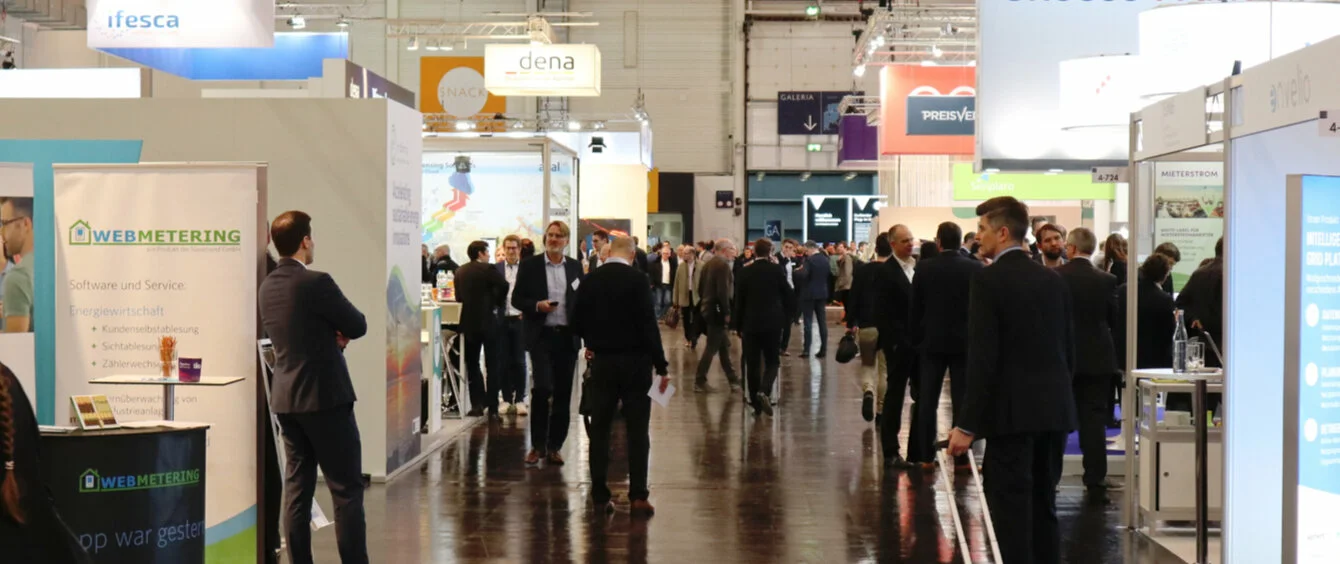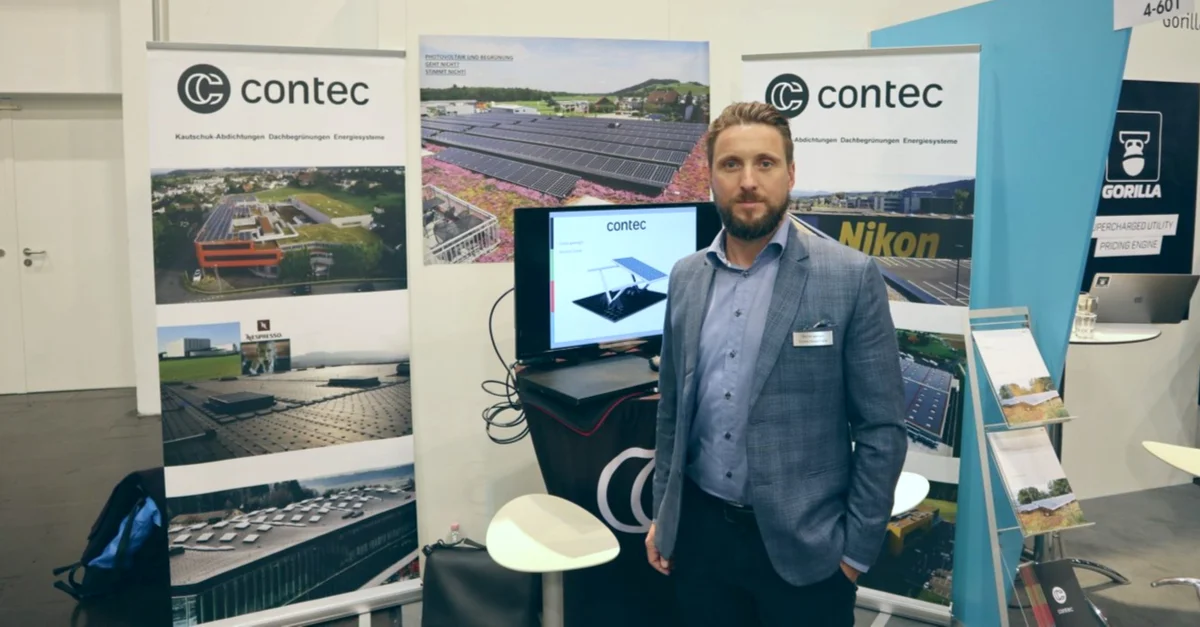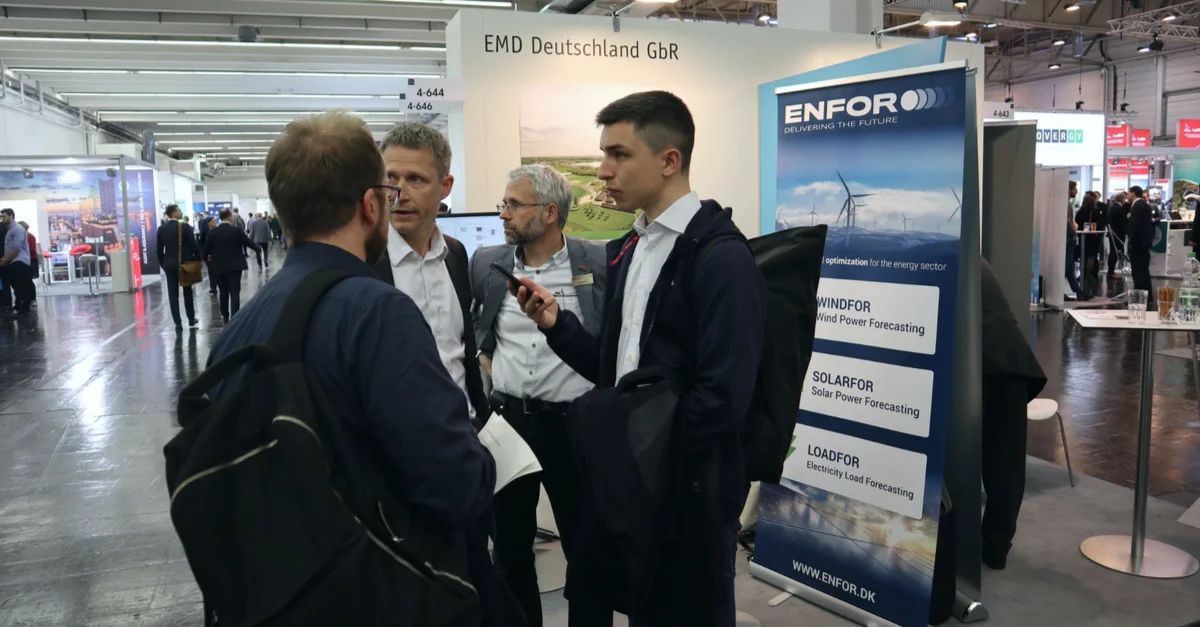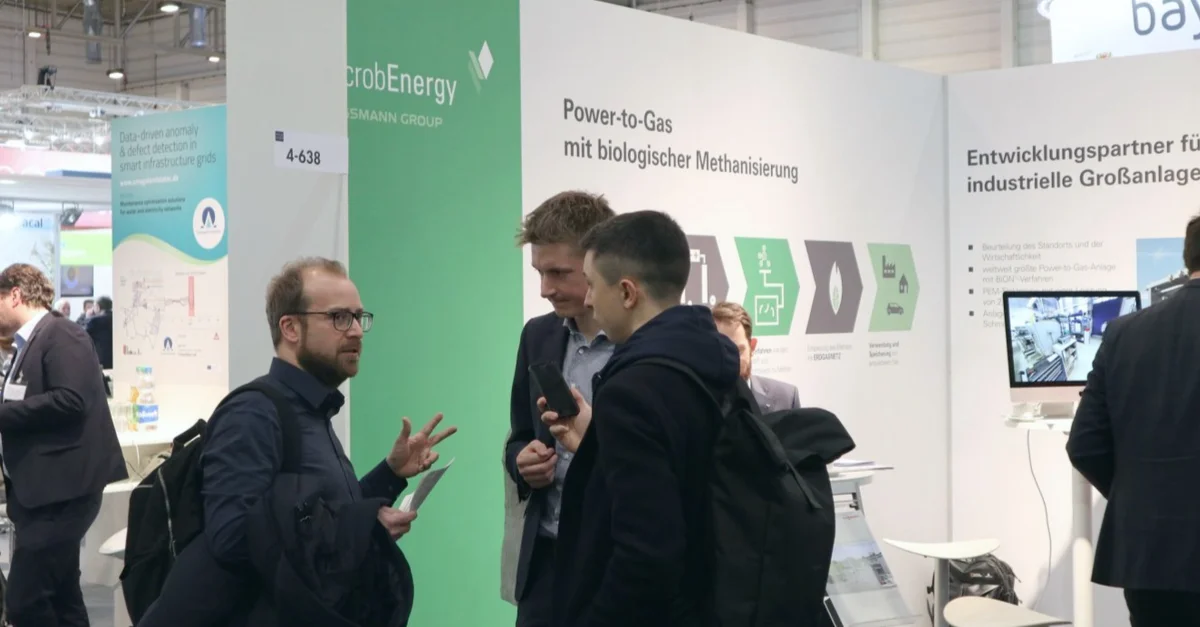The ‘Who’s Who’ of the energy industry met at E-world in Essen in 2020. And once again, everything in Hall 4 was a few sizes smaller. Instead of huge, expensively built stands with tasty snacks and excellent coffee, it was mostly just the bare essentials: chairs, tables, a few stand-up displays and screens for presentations.
There’s a reason for the simple setup: in this hall, start-ups, small companies and research institutes are presenting their products and ideas, some of which are still at the development stage. Many of the exhibitors are young, and the fields they cover are very diverse: one is combining roof greening with photovoltaics, another is working on accurate forecasting for wind power production, and a third is developing ways of converting green energy into methane.
The en:former team was there and spoke to entrepreneurs and employees. This is about three start-ups and their fascinating projects.
Contec Deutschland GmbH, Marcel Jastram (Managing Director)
Contec is a Swiss start-up specializing in roof greening, particularly combined with photovoltaic installations.
How does the technology work?
One of the things our company does is flat roof greening. This is increasingly often a legal requirement, especially for new buildings. Then a few years ago we had an idea: why not combine roof greening with photovoltaics? So we developed the Contec.greenlight system, also called ‘EnergieGrünDach’. Our substructure provides the base, without which the combination would not be possible at all. Photovoltaic modules are installed at a height of about 30 centimetres, so the roof plants can grow under the modules without being completely in the shade. Plus, we use special plants that need little direct sunlight, and are light leaved, to reflect the light.
What’s the advantage?
Many flat roofs have to be greened to comply with regulations. Since we also use these areas for photovoltaics, we can promote the expansion of renewable energy. In decentralised energy supply, we can use the absorption of plants to generate higher energy output on every single-family home or every building with a flat roof. And there are many more advantages to combining roof greening with PV installations: in addition to cooling and consequently higher efficiency, with ‘EnergieGrünDach’ we can create additional biodiversity and new habitats for plants and insects. Habitats are disappearing fast, mainly due to increasing urban development. Moreover, roof greening captures CO2, combatting climate change.
How has this technology been used so far?
We’ve already been using the technology for five years. For example, one of our bigger clients is the Schwarz group. In the past year we’ve also had the privilege of greening the world’s largest single outlet (Hugo Boss, Metzingen) and have sold more than 100,000 units Europe-wide.
What are your plans for the future?
We’re in the process of extending our existing portfolio and establishing a really strong market position.
What’s your background?
Our parent company is Switzerland-based Contec AG, the core business of which is prefabricated EPDM membranes. In Switzerland we’re already market leaders in this field. And for the past five years, we’ve had a wholly owned subsidiary in Germany, giving us a strong position there as well.
How can your idea/project/technology advance the energy revolution and what motivates you personally to contribute?
Our aim is to green every roof. If we can also combine PV systems with our roof greening, that will be real success. The over-arching aim is to give space back to nature, while at the same time producing regenerative energy. In the near future, we want to be able to say, “Even though an area the size of 100 football fields is roofed over every day in Germany, we’re greening an area the size of 50 football fields and these areas are then also used for environmentally friendly energy production, thanks to our ‘EnergieGrünDach.’
Enfor, Mikkel Westenholz (Managing Director) & Peter Ritter (CEO, EMD)
Enfor is a Danish start-up, specialising in energy forecasting and optimisation for the energy sector.
How does the technology work?
Enfor is a web-based software tool that can run on various platforms. Their customers are mostly wind or solar farm operators, but also include municipal utilities supplying heat. Our basic idea is to provide the most accurate and reliable forecasting possible for wind, heating and district heating. We use weather data and information from many different sources, and we rely on machine learning, above all intelligent algorithms, to guarantee that our forecasting is as reliable as possible.
What’s the advantage?
Our efficient processes and accurate forecasts help ensure that plants are operated at optimal conditions. Better forecasting means better planning for the use of wind and solar farms as well as backup power plants.
How has the technology been used so far?
At the moment we’re represented in 22 countries, although most of our customers are from Europe. But the tool is also used in Australia, South Africa and Brazil. We serve three different types of client: utility companies, transmission system operators and traders.
What are your plans for the future?
Our main objective for the future is the continuous improvement of the software and expansion into more and more countries around the world. We are working hard to ensure that the quality and accuracy of our forecasting improves all the time. Above all, the rapid progress of machine learning makes us hopeful that we will constantly become better and more accurate in this field.
What’s your background?
We’re a Danish university spin-off, founded by my two partners in 2006.
How can your idea/project/technology advance the energy revolution?
Our software is making a significant contribution to reducing the costs of the energy revolution. Because with accurate forecasting, wind and solar farms can be run under optimal conditions, needing less standby capacity.
microbEnergy, Robert Böhm (Business Development Manager)
At first sight, Power-to-Gas is nothing new. But microbEnergy is a pioneer with its biological methanisation process. The first full-scale Power-to-Gas facility in the world came on stream in 2015.
How does the technology work?
The basic idea behind Power-to-Gas is to convert regeneratively produced electricity into gas that can be stored – in other words electrons in molecules. The first step is using electricity to split water and obtain hydrogen. Then in the second step, referred to as methanisation, synthetic methane is produced from hydrogen and carbon dioxide. This can help decarbonise sectors such as industry, heating and transport. Our main technical USP (unique selling point) is that we use highly specialised micro-organisms in the decarbonisation process, which is why the method is known as biological methanisation.
What’s the advantage?
The BiON® method developed by microbEnergy can be used very dynamically, thereby optimising energy efficiency, because the micro-organisms are very flexible at converting hydrogen and carbon dioxide into methane. And with our methanisation method, CO2 sources can be used without having to undergo expensive preparation first. Fermentation gasses such as biogas or purification gas, or high calorie gasses such as pyrolysis gas, which have a high proportion of CO2 and CH4, are all very suitable for this. Biological methanisation can then be used as a one-step method for producing synthetic methane and for preparing and storing crude gasses.
How has this technology been used so far?
We are currently building a 2.5 MW Power-to-Gas plant with biological methanisation in Switzerland, at a waste incineration and sewage treatment plant. We expect it to be commissioned in spring of next year. Looking to the future, we want to set this sort of plant up at more interesting locations in Switzerland. The plan is for them to function as sector coupling centres, producing green gas. Generally speaking, this technology can be used wherever large quantities of cheap, renewable energy are available.
What’s your background?
microbEnergy GmbH is part of the Viessmann Group, one of the world leaders in manufacturing climate and energy solutions. When it was founded in 2012, microbEnergy had about 20 employees. We work on Power-to-Gas projects, as a project developer and technology supplier with biological know-how. The plants are actually built by our sister company Schmack Biogas.
How can your idea/project/technology advance the energy revolution?
Our role in the energy revolution is that we develop rapidly transferrable methods that integrate really well into the existing infrastructure. With our technology, we can produce climate-neutral gasses, making a significant contribution to decarbonisation in industry, heating and transport. Personally, I think we need to focus on gas-based energy sources, as well as electrification. This is the only way we can truly succeed in managing the energy revolution as a whole.
Photo credit: © en:former



